Tag Archive: teaching strategies
January 25, 2018
by Carole Zangari -

Reading together with AAC learners can be a great activity for building engagement, language, and literacy skills. Like any other activity, though, it won’t be very helpful in doing that unless we use effective strategies. Today, we share an online module that will help with the basics of interactive book reading. Part of Project CONNECT, The Center to Mobilize Early Childhood Knowledge, which offers full courses for a fee and a limited set of modules (like the one we are sharing today) at no charge. This is a great starting place for anyone looking to better understand how to use shared reading as a way to build communication skills. From there, we can guide families, paraprofessionals, and professionals who work with AAC learners to utilize additional strategies, such as aided language input and descriptive talking, to support those who use some form of augmentative communication. Enjoy learning more about Dialogic... [Read More...]
Filed under: Featured Posts, PrAACtical Thinking
Tagged With: shared reading, teaching strategies
May 4, 2016
by Carole Zangari -

How can we boost the frequency of core vocabulary use across environments? Planning those opportunities and teaching experiences is a big part of that process, both for those new to this approach and those who’ve been doing it for awhile. In this week’s featured video, Gail Van Tatenhove offers ideas for how to structure this so that it is feasible and successful. Thanks to Prentke Romich Deutschland for making ‘Core Counts’ available. Direct link to video: https://www.youtube.com/watch?v=E-xfv3VpvAg
Filed under: Video of the Week
Tagged With: core vocabulary, intervention, teaching strategies
May 30, 2014
by Robin Parker -
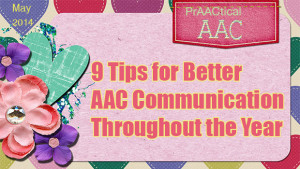
Although Better Hearing and Speech Month is ending, we want to continue best prAACtices in all teaching interactions throughout the year. Here are 9 AAC facilitator tips to help with this goal. Provide Aided Language Input (ALI)– ALI is modeling AAC style. Speak AAC to the AAC user. Use Scaffolding– Scaffolding is a verbal and visual strategy that has the facilitator build upon prior knowledge of the learner in order for the learner to integrate a new concept or skill. Model words and concepts to add information onto what the AAC user already knows and uses. Provide Expansions and Extensions– A form of modeling. Add a word to the spontaneous communication from the learner. The facilitator models a conceptual or grammatical word in the form of a model. Use Recasting– Recasts serve to add or correct information without obstructing the natural flow of communication. Recasting is another form of modelling. The... [Read More...]
Filed under: PrAACtical Thinking
Tagged With: teaching strategies
May 15, 2014
by Robin Parker -

About Teaching Core Words Teaching Core Vocabulary Core Vocabulary All Day Long 5 Things To Do If You’re Not Confident Teaching Core Vocabulary Joining Core and Fringe Vocabulary What’s The Connection: Visual Schedules and Core Vocabulary Core Words and the Curriculum Core Words, Direct Vocabulary Instruction, & The Beginning Communicator Core Vocabulary: Making Sense of Symbols More on Teaching Core Vocabulary Thoughts on Teaching Core Vocabulary Teaching Core Vocabulary with Direct Instruction Strategies Core Vocabulary- Specific Teaching Ideas PrAACtical AAC Core Words & July Fourth: Get Ready, Get Set, Go Cookies and Core August Core Word PrAACtice Ideas September PrAACtice With A Year of Core Words October PrAACtice With A Year of Core Words November Core Word PrAACtice Ideas December Core Word PrAACtice Ideas Core Word Vocabulary Words A Year of Core Vocabulary Another Year of Core Vocabulary The First 12: Getting Started With Core Words More on Core Words:... [Read More...]
Filed under: PrAACtical Thinking
Tagged With: core vocabulary, resources, teaching strategies
April 24, 2014
by Robin Parker -

We love so many blogs, websites, and videos. Parents and professionals take their own time and effort (and often money) to share AAC strategies that have worked for them and their children and students. Here are just a few great ones that we use often when working with graduate students and other professionals to help demonstrate a variety of ways AAC strategies make a difference. Enjoy! Beach Trip (and on the Road) by Dana Nieder at Uncommon Sense Helping an AAC User Learn New Vocabulary by Deanne Shoyer at Small but Kinda Mighty AAC Tips at Kreeds World Complex Needs and Switches: It Could Be You! by Ian Bean at SENICT- Special Education Needs ICS How AAC and Assistive Tech Make Classrooms Better for All by Paula Kluth at Paula Kluth Toward Inclusive Classrooms and Communities
Filed under: PrAACtical Thinking
Tagged With: teaching strategies
October 12, 2013
by Robin Parker -
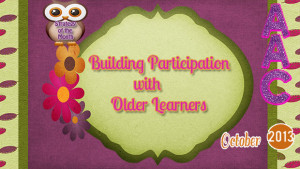
We love active participation for communication and language learning. Actually, we love active participation in all areas of life for us, for our students, for everyone. When Carole introduced the Building Participation Strategy of the Month, she discussed the role of the Participation Model (Beukelman & Mirenda, 1988; 2013). The Participation Model is a framework for understanding the barriers to participation and then from a prAACtical intervention standpoint developing strategies and activities to increase active participation in a variety of (ALL) aspects of life. For the 2012 AAC Awareness Month, we discussed barriers to participation. This year’s focus is on activities and strategies for getting past the barriers to building age appropriate authentic active participation for ALL learners. We have learned that when older learners with significant communication challenges are provided with age appropriate activities and supports, they can be engaged and motivated to participate and can often surprise us with... [Read More...]
Filed under: Strategy of the Month
Tagged With: activities, building participation, older learner, partner strategies, resources, teaching strategies
September 13, 2013
by Carole Zangari -
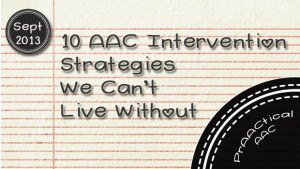
It’s a new semester for us and we’re having lots of conversations with student clinicians about teaching strategies. Here are some of the things they’re putting in their AAC toolkits. Making language visible: Use visual supports to give information, explain, set boundaries, and make expectations clear. Aided language input and focused language stimulation: Teach AAC by speaking AAC. Communication temptations: Make the client want to communicate to get his/her own agenda met Expansions and extensions: The language facilitation strategies we all studied in our language intervention classes work in AAC, too! Repetition with variety: Working on the same thing in different ways is a sure way to build learning and keep treidthings fresh Contrastive examples: Teach through the power of clear examples, both positive AND negative Backward and forward chaining: Great for teaching things that have multiple steps, like sending emails or posting to Facebook Structure: Creating structure helps learner better... [Read More...]
Filed under: PrAACtical Thinking
Tagged With: intervention strategies, teaching strategies
August 11, 2013
by Robin Parker -
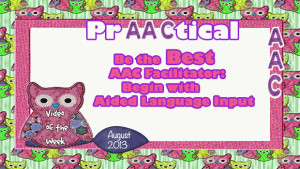
Use Aided Language Input (ALI). If you have never have worked with a student with AAC, are just beginning, or are an expert, one of the best AAC teaching strategies is ALI. Learn or refresh your ALI knowledge with this great video by One’s Kid Place: Children’s Treatment Centre.
Filed under: Video of the Week
Tagged With: aided language input, ALI, teaching strategies
March 9, 2013
by Robin Parker -

Personal narratives are the first story skills that develop. They tell about ourselves and our connection to activities, places, and events. They tell about how we feel about people and experiences. Personal narratives help us structure and organize the events of our lives and even become a way of thinking about ourselves and our identities. We know many AAC users have significant difficulty with narratives. We always wonder though, is it a function of language difficulty or of access, exposure, and PrAACtice or more likely a combination. There are key intervention strategies that help AAC learners be able to tell personal narratives. You probably won’t be surprised by what strategies work but the research from Gloria Soto and colleagues has shown us that when applied to personal narratives, AAC users can be competent story tellers. Some Thoughts on Personal Narrative Assessment Even before assessment of the AAC learner, in all fairness,... [Read More...]
Filed under: Strategy of the Month
Tagged With: Personal Narratives, teaching strategies
July 14, 2012
by Carole Zangari -
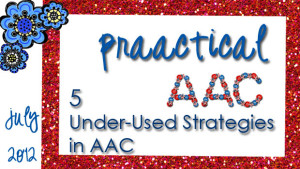
1. Partner-assisted scanning (PAS) offers great flexibility and spontaneity. Don’t want to take your SGD to the beach? A print-out of the screens and PAS is a great option. Missing key messages for the trip to the doctor’s office? A minute of brainstorming and the use of PAS may just save the day. No way for your client to access her device once she’s in bed? A communication board/book and PAS just might do the trick. – 2. Voice banking: For people are likely to lose their speech due to a degenerative disease, like ALS, the option of saving samples of their speech and having it digitized for future use seems to hold great appeal. We’d love to see more SLPs familiarize themselves with this strategy and the tools to implement it, so that this option is more widely used about individuals whose speech is deteriorating. – 3. Qualitative rating... [Read More...]
Filed under: PrAACtical Thinking
Tagged With: aided language input, ALS, ASD, intervention, partner assisted scanning, PAS, rating scales, resources, task analysis, teaching strategies, voice banking









